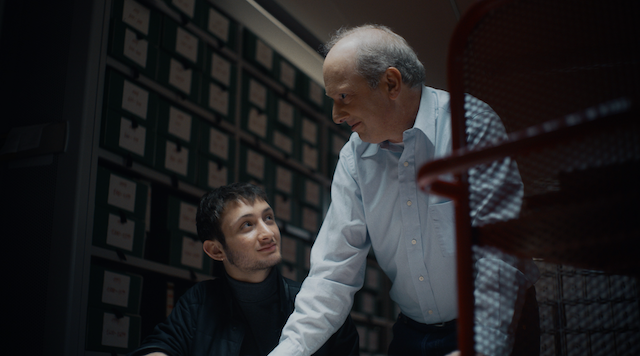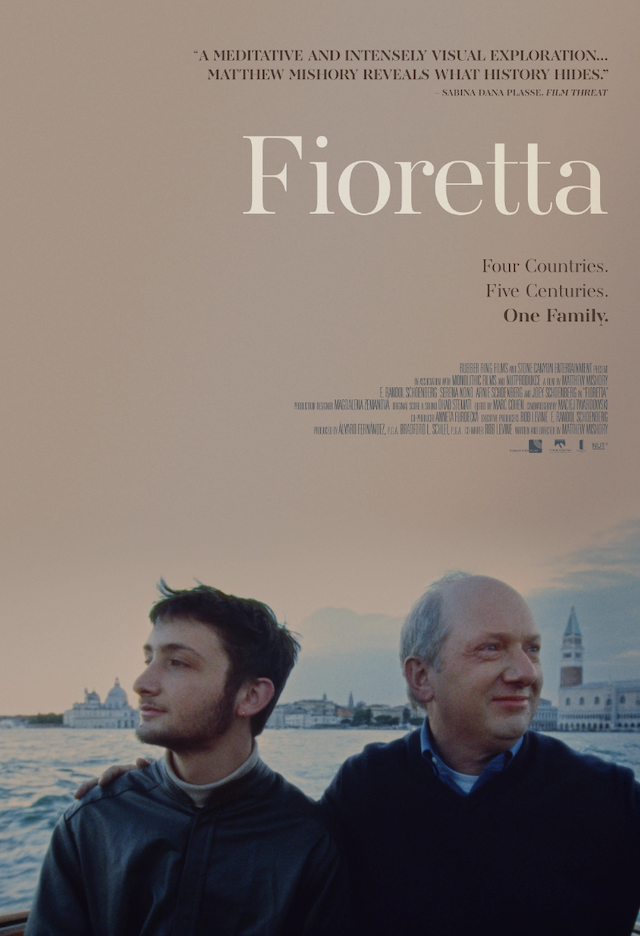
© 2023 Rubber Ring Films LLC
While looking into a yellowing book owned by his great-grandfather, the Jewish American poet Hyam Plutzik wrote what is perhaps the best summary of Matthew Mishory’s touching film, Fioretta. After perusing the faded pages of the century-old book, Plutzik wrote: “I am troubled by the blank fields, the speechless graves./Since the names were carved upon wood, there is no word/For the thousand years that shaped this scribbling fist./…Only Here lies someone,/Here lie no one and no one, your fathers and mothers.”
Fioretta had its local premiere at the New York Jewish Film Festival this week, a triumph of sensitivity and storytelling in a depiction of a father and son journeying through Europe with the aim of coaxing words out of the “speechless graves” of their own ancestors.
The protagonists of this film are E. Randol (Randy) Schoenberg, a Los Angeles attorney who has helped recover many Nazi-looted artworks, and his teenaged son Joey, who aspires to be a chef.
Randy, the grandson of composer Arnold Schoenberg, is a passionate amateur genealogist whose mission in life also involves recovering his own family’s memories looted by time and circumstance, nearly obliterated by ghetto, pogrom, and Holocaust. Randy’s assiduous work has yielded much detail about ancestors stretching back half a millennium to a woman named Fioretta, who lived in the Venice ghetto in the sixteenth century.
In lesser hands, a film about genealogical and archival research could be boring and tedious, but in Marc Mishory’s capable hands, the narrative is lively and engaging, involving treks to quaint cemeteries and chats with eccentric librarians and graveyard curators. Fioretta is further enlivened by convivial encounters with newly found cousins who are thrilled to join Randy’s relentless quest for long-buried roots.
According to the film’s publicists, Fioretta is an “enthralling and personal documentary” that is “a story of kings and mystics, but also of everyday people who lived through centuries of historical upheaval throughout Europe, taking Randy and Joey—and the viewer—on a journey from California to Austria, the Czech Republic, and Italy.” Throughout, Mishory adroitly uses a mobile camera, not a fixed one, to underscore the fluid nature of their meanderings, as opposed to the style of documentarians such as Ken Burns, who favors a more static visual approach.

© 2023 Rubber Ring Films LLC
Their journey also includes a moving visit to Theresienstadt, the Nazi concentration camp in what is now the Czech Republic that served as a home for thousands of exiled Jews, many of them elderly and cultured. Fioretta is thus a deeply textured film that weaves tragedy and triumph, doom and delight, catastrophe and charm into a seamless whole.
Many of the most touching scenes in this film were shot in Vienna and Prague, giving the viewer a glimpse into the rich, Jewish-inflected culture that once flourished in the old Habsburg lands before the Nazis brutally eradicated everything.
From Kafka’s grave to a streetside monument constructed of keys near Freud’s home, Fioretta unlocks all that is noble and enduring in a vanished world. Time and time again, the cast of this impressive film are shown ritually placing stones on the gravestones of the dead, fulfilling the duty of the living to insure their forebears never “endure the final death of being forgotten,” in the words of a rabbi in the documentary. (On Hyam Plutzik’s gravestone, it should be noted, are inscribed these words from another of his poems: “Nothing can be done, but something can be said at least.”)
While Fioretta is certainly important as a witness to the past, it also serves as a cautionary tale for our present era which is witnessing a dangerous revival of anti-Semitism in America, once revered as an unshakeable bulwark against the fanaticism that is so pointedly documented here.
Rating: A+
Check out more of Edward’s articles.
Here’s the trailer of the film.


Thank you for the terrific review. Could you correct Matthew Mishory’s name in the article where it says “but in Marc Mishory’s capable hands.” Should be Matthew, not Marc. Thanks again,
Randy